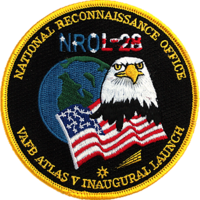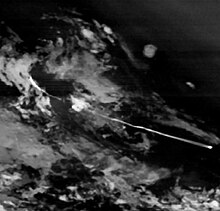
Delta IV was a group of five expendable launch systems in the Delta rocket family introduced in the early 2000s. Originally designed by Boeing's Defense, Space and Security division for the Evolved Expendable Launch Vehicle (EELV) program, the Delta IV became a United Launch Alliance (ULA) product in 2006. The Delta IV was primarily a launch vehicle for United States Air Force (USAF) military payloads, but was also used to launch a number of United States government non-military payloads and a single commercial satellite.
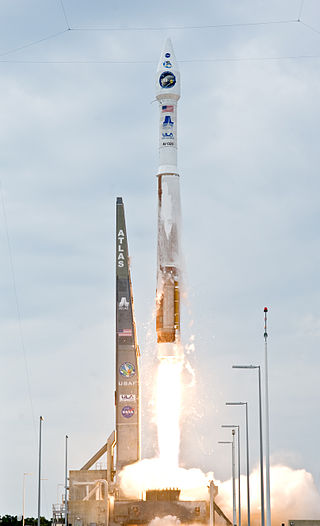
Atlas V is an expendable launch system and the fifth major version in the Atlas launch vehicle family. It was originally designed by Lockheed Martin, now being operated by United Launch Alliance (ULA), a joint venture between Lockheed Martin and Boeing. It is used for DoD, NASA, and Commercial payloads. It is America's longest-serving active rocket. After 87 launches, in August 2021 ULA announced that Atlas V would be retired, and all 29 remaining launches had been sold. As of 6 October 2023, 17 launches remain.

The Minotaur is a family of United States solid fuel launch vehicles derived from converted Minuteman and Peacekeeper intercontinental ballistic missiles (ICBM). They are built by Northrop Grumman via contract with the Air Force Space and Missile Systems Center's Space Development and Test Directorate (SMC/SD) as part of the Air Force's Rocket Systems Launch Program which converts retired Intercontinental Ballistic Missiles into space and test launch systems for U.S. government agencies.

United Launch Alliance, LLC, commonly referred to as ULA, is an American aerospace manufacturer, defense contractor and launch service provider that manufactures and operates a number of rocket vehicles that launch spacecraft into orbits around Earth and other bodies in the Solar System.
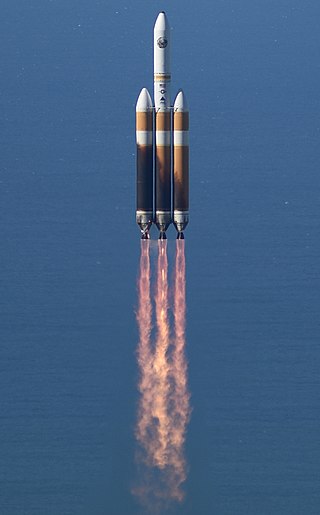
The Delta IV Heavy is an expendable heavy-lift launch vehicle, the largest type of the Delta IV family. It is the world's third highest-capacity launch vehicle in operation, behind NASA's Space Launch System and SpaceX's Falcon Heavy and closely followed by CASC's Long March 5. It is manufactured by United Launch Alliance (ULA) and was first launched in 2004. ULA will retire the Delta IV Heavy in 2024. As of June 2023, one flight remains.

Minotaur IV, also known as Peacekeeper SLV and OSP-2 PK is an active expendable launch system derived from the LGM-118 Peacekeeper ICBM. It is operated by Northrop Grumman Innovation Systems, and made its maiden flight on 22 April 2010, carrying the HTV-2a Hypersonic Test Vehicle. The first orbital launch occurred on 26 September 2010 with the SBSS satellite for the United States Air Force.

USA 202, previously NRO Launch 26 or NROL-26, is a classified spacecraft which is operated by the United States National Reconnaissance Office. It is an Advanced Orion ELINT satellite. According to Aviation Week, it "fundamentally involves America's biggest, most secret and expensive military spacecraft on board the world's largest rocket." The combined cost of the spacecraft and launch vehicle has been estimated to be over US$2 billion.

USA-225, also known as the Rapid Pathfinder Prototype (RPP) and NRO Launch 66 (NROL-66), is an American satellite which was launched in 2011. The satellite is being used to perform technology demonstration and development experiments, including advanced dosimeters to characterize the space environment from a 1,200 kilometer low Earth orbit. It is operated by the United States National Reconnaissance Office.
KySat-1 was an American satellite which was to have been operated by Kentucky Space. Designed to operate for eighteen to twenty four months, it was lost in a launch failure in March 2011 after the Taurus launch vehicle carrying it failed to achieve orbit.
USA-227, known before launch as NRO Launch 27 (NROL-27), is an American communications satellite which was launched in 2011. It is operated by the United States National Reconnaissance Office.
USA-229, known before launch as NRO Launch 34 (NROL-34), is a pair of American signals intelligence satellites which were launched in 2011. They are operated by the United States National Reconnaissance Office.
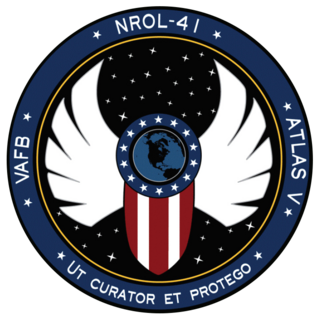
USA-215, also known as NRO Launch 41 or NROL-41, is an American reconnaissance satellite, operated by the National Reconnaissance Office (NRO). Launched in 2010, it has been identified as the first in a new series of imaging radar satellites, developed as part of the Future Imagery Architecture (FIA) programme, to replace the earlier Lacrosse spacecraft.
USA-234, also known as NRO Launch 25 or NROL-25, is an American reconnaissance satellite, operated by the National Reconnaissance Office. Launched from Vandenberg Air Force Base in 2012, it has been identified as the second radar imaging satellite to be launched as part of the Future Imagery Architecture programme.
USA-184, also known as NRO Launch 22 or NROL-22, is an American signals intelligence satellite, operated by the National Reconnaissance Office. Launched in 2006, it has been identified as the first in a new series of satellites which are replacing the earlier Trumpet spacecraft.
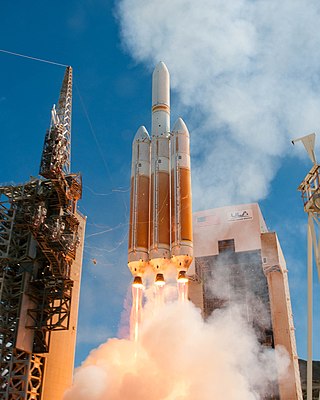
USA-245 or NRO Launch 65 (NROL-65) is an American reconnaissance satellite which is operated by the National Reconnaissance Office. Launched in August 2013, it is the last Block 4 KH-11 reconnaissance satellite, and the last official spacecraft to be launched in the Keyhole program.
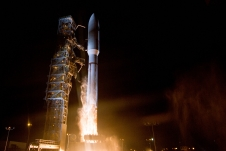
USA-247, also known as NRO Launch 39 or NROL-39, is an American reconnaissance satellite, operated by the National Reconnaissance Office and launched in December 2013. The USA-247 launch received a relatively high level of press coverage due to the mission's choice of logo, which depicts an octopus sitting astride the globe with the motto "Nothing Is Beyond Our Reach". The logo was extensively criticized in light of the surveillance disclosures in July 2013.

USA-261, also referred to as Orbital Test Vehicle 4 (OTV-4) or AFSPC-5, is the second flight of the second Boeing X-37B, an American unmanned vertical-takeoff, horizontal-landing spaceplane. It was launched to low Earth orbit aboard an Atlas V rocket from Cape Canaveral on May 20, 2015. Its mission designation is part of the USA series.

